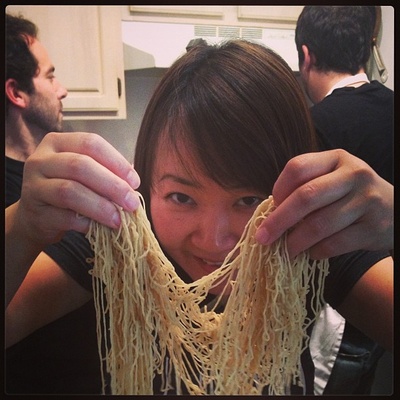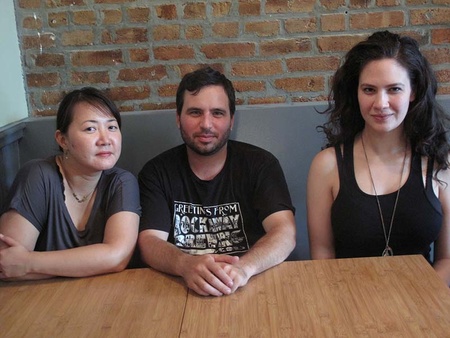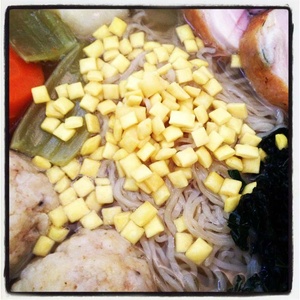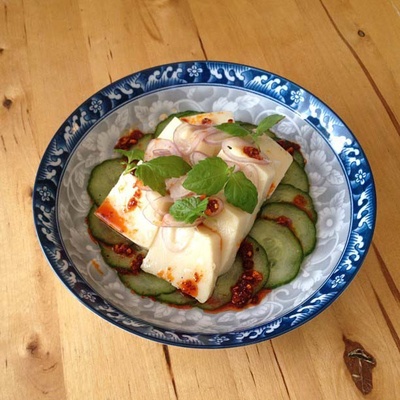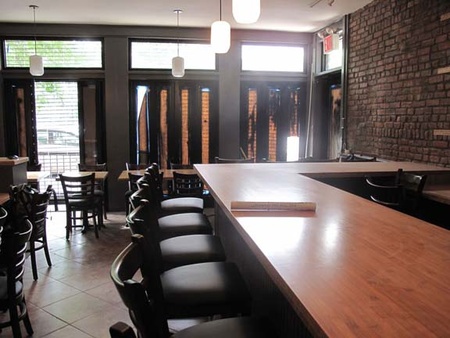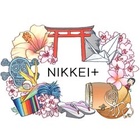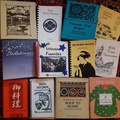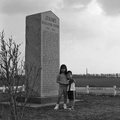Sawako Okochi has always had a sense of adventure. When she finished high school in Hiroshima and her classmates were deciding which Japanese universities to apply to, her sights were set farther away.
“Instead of going to a Japanese university, I wanted to go to an American university,” says Okochi, who had a goal of becoming a translator. “I decided to go to Texas because it was one of the cheapest places to live, and also I wanted something more in the countryside. I don’t know…the sound of ‘Texas.’ It just fascinated me.”
Eventually disillusioned with her original course of study, she began to focus on acquiring cooking skills. Of the culinary programs she applied to, only one in New York City completed all the required paper work for a foreign student. Before long, she was studying culinary arts at The New York Restaurant School (now the Art Institute of New York City). During her school program, she worked at Aki, a downtown Japanese restaurant, and interned at the destination restaurant Chanterelle. She eventually ended up in the kitchen at Anita Lo’s Annisa and later at the seminal Red Hook American restaurant, The Good Fork.
Following those two long stints in established kitchens, Okochi developed one of the first of what would become known as “pop-up” restaurants, the Otakara Supper Club, a series of dining events held in private residences.
“We were trying to get my food out there,” says Okochi. “We wanted the world to see it. It wasn’t a restaurant setting, but we wanted to do something that didn’t have any restraints of a restaurant.”
The Otakara Supper Club brought her more attention among restaurateurs in New York City, and she returned to a more formal restaurant environment, revitalizing the kitchen at the cocktail-centric Lani Kai.
But she remained, as always, adventurous, seeking ways to create food that is uniquely her own.
Aaron Israel grew up in a Jewish-American home in Great Neck, Long Island. With a strong interest in art, he studied painting throughout high school and went on to earn a B.F.A. as a painting major at the Maryland Institute College of Art. In high school Israel also began to develop an interest in cooking which continued as he studied painting and ceramics. By the time he found himself in Italy, during his last years in college, cooking was as strong an interest as the visual arts.
“I was doing a lot of painting, but I kept cooking and it became like a creative outlet,” says Israel. “I found a lot of the process in cooking similar to what I like about painting. Just the way you go about layering flavors the way you would layer colors. Not in a visual way—a painting is pretty and I make a pretty plate—but more the actual process. I was really doing a lot more cooking than art, and at that point, I said, ‘When I get out of art school, I want to cook.’ ”
With the help of friends who were already established in New York City’s restaurant community, the self-taught Israel got an introduction that led to a job at August, and eventually he became part of the team that opened Andrew Carmellini’s A Voce. At A Voce, he became friends with Rich Torrisi, who called on Israel to help develop and open the groundbreaking Torrisi Italian Specialties. From there, he became a key part of Mile End, the immensely popular reinterpretation and reintroduction of classic Jewish deli foods by way of Montreal.
Israel was working in, supporting, and developing remarkably successful dining environments, but throughout his professional life as a chef, he always envisioned opening his own restaurant.
“You can work for really great people and learn really great things and it’s so important,” says Israel. “But if you work for someone else, it’s still about them and fitting into what they want. There’s something great about that, but I was at a point where I knew what I wanted. I didn’t want to play by other people’s rules anymore.”
By this time, Okochi and Israel had met, introduced by mutual friends while Israel was at Mile End and Okochi at The Good Fork. A relationship developed, they fell in love, and were married. While each was looking for a way to create their own food, they realized that the dynamics of restaurant life in New York City gave them limited choices when it came to pursuing their own food and maintaining their relationship.
“Being a chef is such a commitment of time,” says Israel. “We said, well, if you’re going to be a chef at some other restaurant putting all your energy into that, and I’m going to be a chef at this restaurant, putting all my energy into this, why don’t we just do it together?”
At this point in their careers and relationship, it seemed to make sense.
“We said we would either see each other all the time, or never see each other!” says Okochi.
And so was born Shalom Japan, their restaurant that is slated to open this summer in Brooklyn. Together they would create food that drew from both their cultures, but would be uniquely their own.
To complete their management team, Okochi and Israel turned to Micaela Grossman, an experienced restaurant manager and a front-of-house and beverage specialist who had worked with Israel at Torrisi.
“Sawa and I both knew that there’s no way, if we were doing a restaurant, that we could deliver the quality of wine knowledge and all the service stuff that she has,” says Israel. “We’re chefs. We don’t have the in-depth knowledge of the POS (computerized sales) system the way she does. She rounds out our team in a different way. You need different pieces to complement each other.”
Can two experienced professional chefs, married to each other, work side-by-side in a kitchen, creating and executing food that satisfies their individual creative impulses?
Israel is quite confident that they can work well together. “When it comes to a collaboration, it’s about bringing two very different things to the table and a respect for what each of us is doing,” he says.
Grossman also expresses great confidence that having a married couple in the kitchen will be an asset, not a cause for concern.
“With a productive collaboration,” she says, “there has to be that sense of trust and honesty, which being in a relationship gives you.”
The food is defined by who they are and how they work together.
“When you grow up and you’re sort of bound by tradition, sometimes it’s harder to think outside the box,” says Israel. “So when I make something that I’m super-familiar with and pass it on to Sawa, she may look at it in a different light that I haven’t seen, and I can bring some of that to her. Maybe it’s something we’ve experienced someplace else. Maybe it’s something I grew up eating. Maybe it’s something she grew up eating. It always ends up being ours, but the inspiration can come from so many different sources. Sometimes it’s her idea about Jewish food, and sometimes it’s my idea about Japanese food. It’s a dialogue.”
“We were thinking of a lot of different ways to describe it,” says Okochi. “Inauthentically authentic Japanese Jewish food or New American with Japanese and Jewish influences.”
They have already identified some new items that will be on the Shalom Japan menu, including their house-made chickpea tofu.
“That’s a good example of Sawa saying, ‘I know how to make tofu,’” Israel explains. “She makes it, cooks the soybeans, and I say, ‘If this were chickpeas, you could make falafel out of this.’”
“Another one we’re working on is challah with sake kasu (leftover lees from sake production),” says Okochi, inspired after reading that adding sake kasu to bread gives it a nice fragrance. “(Israel) has a really good challah recipe. The first one we made was terrible, the second one was good, and the third one we made was really, really good.”
They had the team. They knew how they would work together. In March, they signed a lease on a quiet corner in South Williamsburg. With financing raised from friends, families, mentors, and past professional collaborators, they were on their way to creating their unique restaurant.
Then they did one more adventurous thing: they initiated a Kickstarter campaign to generate a final $15,000 to put the “finishing touches” on Shalom Japan.
Why Kickstarter? They had already gathered sufficient funding needed to make a scheduled summer opening.
Grossman explains that it was about more than just the money.
“One of the things about Kickstarter is that it allows people to engage with the restaurant and feel a sense of ‘This is my restaurant,’” says Grossman. “You can open the doors without having to actually open the doors. They get to meet all of us through the campaign. It’s this sense of building excitement. We know we have something great and we want to share it with you, and what better way to get it out there?”
They created an introductory video for the campaign and set a goal of raising $15,000 in one month—from June 26 through July 26. Emails were sent, a Facebook page created, and word went out. But the team wasn’t sure what the outcome would be. As is customary with Kickstarter, if 100% of the goal is not achieved by the scheduled completion date, they would receive none of it.
Remarkably, the entire targeted amount was achieved in the first ten days.
“Yeah, it was amazing,” says Okochi. “The last push came from Japan. My mother, my grandmother, my mother’s best friend, her daughters, and my Dad. It was the last $3,000. Aaron and I were at a wedding on the 4th when we got the text from Micaela that we reached our goal. We were so happy!”
With the campaign open for an additional twenty days, the team has set an unofficial new goal of raising another $5,000.
“We will be continuing on [with the campaign],” says Grossman. “It’s been such an amazing outpouring of support! With continued support, we will be able to get closer and closer to the restaurant we have been striving to create.”
At the end of a long journey through a variety of restaurants, kitchens, and culinary cultures, that restaurant has become Shalom Japan.
*This article was originally published on JapanCulture•NYC on July 20, 2013. Visit Shalom Japan’s website: shalomjapannyc.com.
© 2013 Tamio Spiegel


